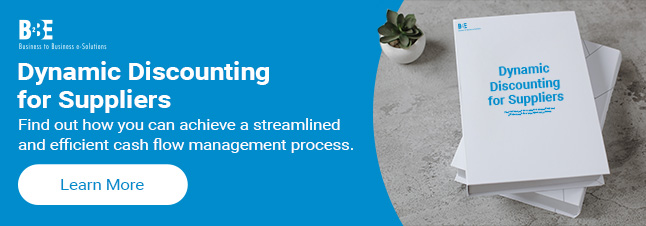Businesses strive to optimise their cash flow and maintain financial stability. Early payment discounts have become a helpful tool to achieve this. Businesses strive to optimise their cash flow and maintain financial stability. Early payment discounts have become a helpful tool to achieve this.
Businesses can benefit from offering discounts to suppliers in exchange for faster payments. This can improve working capital management, enhance supplier relationships, and potentially lead to cost savings.
Cash flow management is essential in today’s innovative business environment. Early payment discounts have become increasingly popular to maximise financial advantage. This is a great way to gain an edge in a competitive market.
Dynamic discounting platforms have emerged as innovative solutions for traditional early payment discount programs. They streamline the process and make it more efficient for both buyers and suppliers. Platforms use technology to automatically calculate, negotiate, and process early payment discounts. This gives businesses an easy way to manage their cash flow and keep good relationships with their suppliers.
This blog will explain the basics of early payment discounts. We will cover how they work, how to calculate them and best practices for managing them. This blog will explain the basics of early payment discounts. We will cover how they work, how to calculate them and best practices for managing them.
Understanding Early Payment Discounts
Early payment discounts are a type of incentive offered by businesses to their suppliers in exchange for faster payment of invoices. Discounts are often given as a percentage of the total invoice amount. They are offered to suppliers as an incentive for accepting early payment instead of waiting for the full payment term.
The primary benefit of early payment discounts is improved cash flow management. Businesses can improve their cash position by offering discounts to suppliers for early payment. This accelerates cash inflows, allowing them to access funds sooner.
Cash flow gaps or financing operational activities can be challenging for a business. This is where the advantages of this method come into play. It can help to bridge the gaps and finance operations.
Early payment discounts also foster stronger supplier relationships. Businesses can incentivise suppliers to accept early payments.
This builds goodwill and trust between them. It also leads to preferential treatment, better pricing, and improved supplier performance. This can be especially important for businesses that rely on a reliable and efficient supply chain to maintain their operations.
How Early Payment Discounts Work
Businesses often offer early payment discounts to their suppliers as an incentive. This encourages suppliers to make payment of invoices faster.
Buyers may also ask for discounts as a way to manage their cash flow. Doing so helps them to purchase goods at a cheaper price. The discount can be expressed in two ways: as a percentage off the total invoice amount or as a fixed APR%. This discount is offered as a reward for early payment acceptance.
The process typically involves the following steps:
- Invoice Submission: The supplier submits an invoice to the buyer for goods or services rendered, according to the agreed-upon payment terms.
- Discount Terms: The buyer and supplier agree on the discount terms, including the discount percentage, the time period within which the discount is valid, and the early payment deadline.
- Payment Calculation: Either the buyer or supplier calculates the early payment discount amount based on the discount percentage or APR% and the total invoice amount.
- Payment Decision: Either the buyer or supplier decides whether to accept the early payment discount and wait for the full payment term to expire.
- Payment Processing: If the supplier accepts the early payment discount, the buyer processes the payment for the discounted amount before the early payment deadline.
- Record Keeping: Both the buyer and the supplier maintain records of the early payment discount transaction for their accounting and financial reporting purposes.
It is crucial to recognise that the method may fluctuate based on the buyer and supplier’s agreement. Utilising a dynamic discounting platform can facilitate and automate the process, increasing efficiency.
By offering early payment discounts, businesses can incentivise their suppliers to accept faster payments, which can help improve cash flow management and provide access to funds sooner. Suppliers, on the other hand, can benefit from improved cash flow and potentially build stronger relationships with their buyers. The use of dynamic discounting platforms can further enhance the efficiency and effectiveness of the early payment discount process, benefiting both buyers and suppliers alike.
Calculating Discounts
Let’s say a supplier offers a 2% discount for payment within 10 days on an invoice with a total value of $10,000.
The standard payment terms for this invoice are net 30, meaning the full amount is due in 30 days.
If the buyer chooses to take advantage of the early payment discount and pays within 10 days, they would deduct the discount from the total invoice amount:
Discount amount = 2% x $10,000 = $200
New invoice total = $10,000 – $200 = $9,800
By paying early, the buyer saves $200, which represents a 2% discount on the invoice value.
Communication between buyers and suppliers is essential. They must come to a mutual understanding of the discount percentage and payment terms. This will ensure the accuracy of the calculation.
Buyers may offer different discount percentages for different early payment deadlines. Suppliers need to review and understand the terms to make informed decisions.
A dynamic discounting platform can simplify the calculation process. It can automatically calculate the early payment discount based on the agreed-upon terms. This makes it easier for both buyers and suppliers to manage and track early payment discounts accurately.
Tips for Managing Early Payment Discounts
Managing early payment discounts effectively is crucial for maximising the benefits of this financial advantage.
Here are some tips for both buyers and suppliers to effectively manage early payment discounts:
- Set Clear and Transparent Terms: Buyers and suppliers should establish clear and transparent terms for early payment discounts, including discount percentages, payment deadlines, and any other relevant conditions. Using a dynamic discounting platform can streamline this process, allowing for easy communication and negotiation of discount terms.
- Monitor Payment Deadlines: Buyers should closely monitor payment deadlines to ensure timely payments and avoid missing out on early payment discounts. Suppliers should also keep track of payment deadlines to ensure they receive the agreed-upon discount if they choose to accept the early payment option.
- Optimise Cash Flow: Buyers can optimise their cash flow by strategically selecting invoices to pay early and take advantage of early payment discounts, while suppliers can use the early payment discounts to improve their cash flow by receiving payments sooner. A dynamic discounting platform can help automate this process and provide insights into optimising cash flow management.
- Leverage Automation: Using a dynamic discounting platform can streamline the entire process of managing early payment discounts. These platforms can automatically calculate discounts, facilitate communication and negotiation between buyers and suppliers, and provide real-time visibility into discount offers and payments.
- Communicate and Collaborate: Effective communication and collaboration between buyers and suppliers are key to successfully managing early payment discounts. Buyers and suppliers should keep lines of communication open and work together to ensure smooth and timely processing of early payment discounts.
Implementing early payment discounts can be made easier with a dynamic discounting platform. This platform can automate the process and provide real-time visibility of discount offers, payments and deadlines.
Follow these tips and use a dynamic discounting platform. This helps buyers and suppliers manage early payment discounts. They can also optimize their cash flow management strategies.
Conclusion: Leveraging for Financial Advantage
In today’s fast-paced business environment, early payment discounts offer a compelling financial advantage for both buyers and suppliers. Buyers can optimise their cash flow by strategically paying invoices early and increasing profit margin, while suppliers can improve their cash flow by receiving payments sooner. Leveraging early payment discounts can lead to increased liquidity, improved supplier relationships, and enhanced financial performance.
Dynamic discounting platforms provide an effective solution for managing early payment discounts, offering automation, communication, and negotiation capabilities that streamline the entire process. These platforms enable buyers and suppliers to easily calculate discounts, communicate and collaborate on discount terms, and monitor payment deadlines, resulting in improved cash flow management and financial advantage.
In conclusion, early payment discounts are a powerful tool for optimising cash flow and improving financial performance. By leveraging dynamic discounting platforms and following best practices for managing early payment discounts, businesses can unlock significant benefits and gain a competitive edge in today’s dynamic business landscape.


